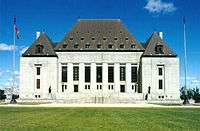R v Sharpe
| R v Sharpe | |
|---|---|
|
| |
| Hearing: January 18, 19 2000 Judgment: January 26, 2001 | |
| Full case name | Her Majesty The Queen v John Robin Sharpe |
| Citations | [2001] 1 S.C.R. 45, 2001 SCC 2 |
| Ruling | Appeal allowed, charges remitted to trial. |
| Court Membership | |
|
Chief Justice: Beverley McLachlin Puisne Justices: Claire L'Heureux-Dubé, Charles Gonthier, Frank Iacobucci, John C. Major, Michel Bastarache, Ian Binnie, Louise Arbour, Louis LeBel | |
| Reasons given | |
| Majority | McLachin C.J. (paras. 1 - 130), joined by Iacobucci, Major, Binnie, Arbour and LeBel JJ. |
| Concurrence | L'Heureux-Dubé, Gonthier and Bastarache JJ. (paras. 131 - 243) |
R v Sharpe, [2001] 1 S.C.R. 45, 2001 SCC 2, is a Canadian constitutional rights decision of the Supreme Court of Canada. The Court upheld the child pornography provisions of the Criminal Code as a valid limitation of the right to freedom of expression under section 2(b) of the Canadian Charter of Rights and Freedoms. In doing so, it reversed a ruling by the British Columbia Supreme Court. That opinion, issued by Justice Duncan Shaw, held that the law was what he called a "profound invasion" of rights of privacy and freedom of expression found in the Charter of Rights and Freedoms.[1] Prior to its reversal by the higher court, the ruling sparked extensive public complaints, and more than half of the Members of Parliament called for action by the Prime Minister to override the ruling.[1]
Background
It began in 1995 when John Robin Sharpe was returning from a trip to Amsterdam where he had traveled to meet Edward Brongersma, a Dutch jurist and advocate of pederasty and pedophilia. Upon return, Canada Customs found a collection of computer discs containing a text entitled "Boyabuse". A later search of his Vancouver apartment revealed a collection of photographs of nude teenage boys, some of them engaged in sexual acts with one another. Sharpe was arrested and charged with illegal possession under s. 163.1(4) of the Criminal Code, and for possession for the purposes of distribution or sale under s. 163.1(3) of the Code.
Acting in his own defence, Sharpe challenged the criminal provisions as violation of freedom of expression under section 2(b) of the Charter. Sharpe argued before a court that laws regarding the possession of child pornography violated his freedom of thought and expression. He presented a fairly controversial argument that since he was interested in teenage boys, he should be entitled to pornographic material relating to his sexual interests. Nonetheless, the law he was charged under was eventually upheld with some exceptions regarding written pornography.
During his trial, the prosecutor argued for the harmfulness of child pornography possession and why it should remain illegal. Sharpe attempted to refute the prosecution's claims that child porn and child sexual abuse are a related paradigm by claiming that the legal attitudes towards pornographic representations of children 'creates a victim' instead of starting with one. The line between production, distribution, and possession was also espoused by Sharpe. He further argued that in many instances possession of child pornography could act as a catharsis in preventing child sexual abuse. In regard to provisions on written pornography, Sharpe argued that the law in question targeted the political advocacy of pederasty and served little purpose in protecting children from sexual abuse. The charges in respect to Sharpe's writings were eventually dismissed when he argued artistic merit with the assistance of an English professor who compared his written works to 'transgressive expression' parallel to Marquis de Sade's 120 Days of Sodom.
Opinion of the Court
Chief Justice Beverley McLachlin, writing for the majority, held that the provision in the Code violated the freedom of expression but was justified under section one as the government objective of protecting children from exploitation was proportional to the violation.
The Court, however, finds that the provisions were too broad for including two types of material that should not constitute child pornography as they do not pose a direct potential harm to children. First, where the written or visual representations were created and possessed by the accused for exclusive personal use, and second, where "visual recordings created by or depicting the accused that do not depict unlawful sexual activity and are held by the accused exclusively for private use."
Question of law
Interpreting "person" in accordance with Parliament's purpose of criminalizing possession of material that poses a reasoned risk of harm to children, it seems that it should include visual works of the imagination as well as depictions of actual people. Notwithstanding the fact that 'person' in the charging section and in s. 163.1(1)(b) refers to a flesh-and-blood person, I conclude that "person" in s. 163.1(1)(a) includes both actual and imaginary human beings.
Justice McLachlin, under section (7), was given the ability to interpret the law. Her interpretation in regards to making works of the imagination (imaginary human beings) illegal was used as a legal precedent referenced in later cases for prosecuting people who imported Japanese artwork which was and still is legal in both Japan and the United States where the convicted men imported it from. This precedent referred to Sharpe's stories, and was used as a precedent for convictions of people who possessed images and illustrated stories (manga, Japanese comics).
References
- 1 2 Walters, Gregory J. (2002). Human Rights in an Information Age: A Philosophical Analysis. University of Toronto Press. p. 76. ISBN 0-8020-8550-4.
- ↑ R. v. Sharpe (26 January 2001). Retrieved February 20, 2006.
External links
- Full text of Supreme Court of Canada decision available at LexUM and CanLII
